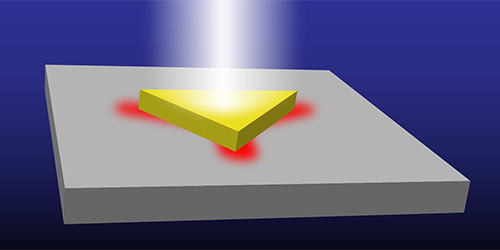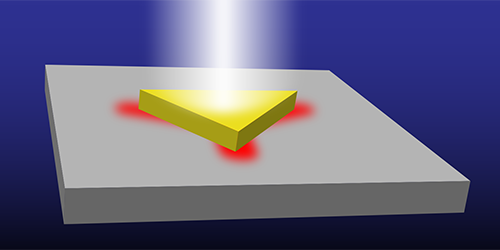A Frequency Doubler Controlled by Light
Zap certain materials with a laser, and out comes light at twice the frequency. This frequency doubling is an example of a “second-order optical effect,” by which two photons interact to facilitate the generation of new colors. Harnessing such effects could help maximize the potential of optoelectronics, but the repertoire of usable materials is limited. Now, researchers have used a laser pulse to momentarily enable frequency doubling in a material that normally doesn’t support it, allowing the creation of second-order optical effects on demand, using nothing but light.
Second-order optical effects arise whenever there is a loss of symmetry in a material’s crystal structure. Away from surfaces and interfaces, most optical media are symmetric, however, which hinders second-order effects in the bulk of the material. Previously, researchers have broken that symmetry by applying external strains or electric fields. Now, Mohammad Taghinejad of the Georgia Institute of Technology in Atlanta and colleagues have found a new way.
They laid an array of thin gold triangles on a slab of titanium dioxide and illuminated them with a pulse of red laser light. The light excited electrons at the surface of the gold, some of which migrated to the titanium dioxide from the triangles’ tips. Meanwhile, the team rapid-fired pulses using a separate laser and recorded the frequency of the light that bounced back. For a couple of picoseconds after the electrons jumped into the titanium dioxide, the reflected light doubled in frequency. The asymmetric migration of electrons, shaped by the gold triangles, fleetingly broke the titanium dioxide’s symmetry.
This is the first time that this mechanism for symmetry breaking has been achieved via all-optical means. The team hopes that their demonstration is a step towards bringing controllable second-order optical effects to a diverse medley of materials.
This research is published in Physical Review Letters.
–Christopher Crockett
Christopher Crockett is a freelance writer based in Arlington, Virginia.
Correction (6 January 2020): The Synopsis was modified to clarify that the novelty in the technique was in the mechanism for the symmetry breaking, not the symmetry breaking itself.





